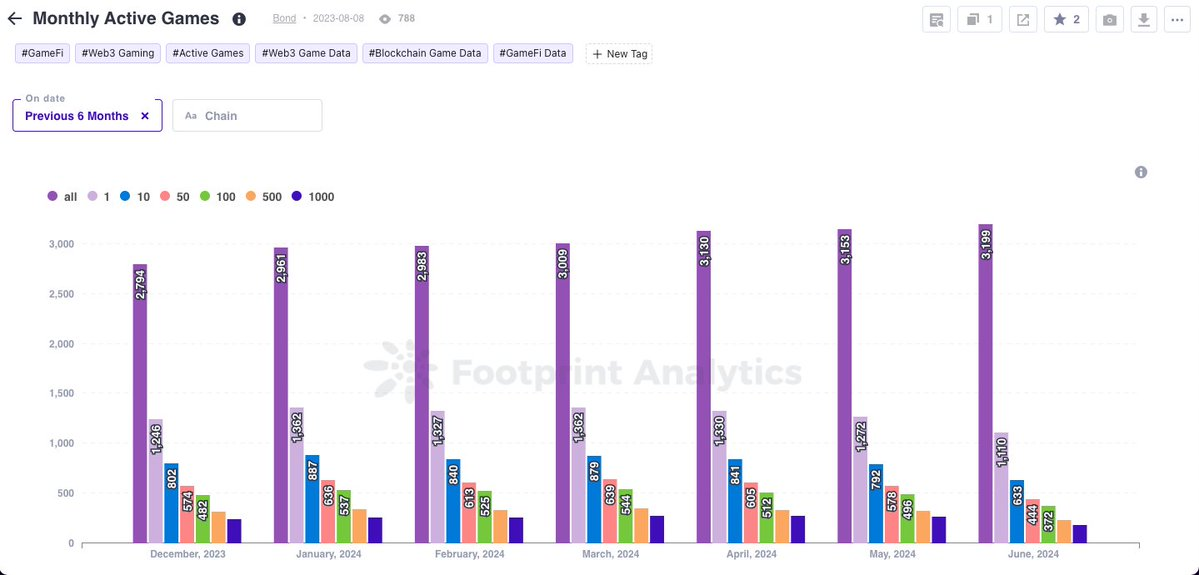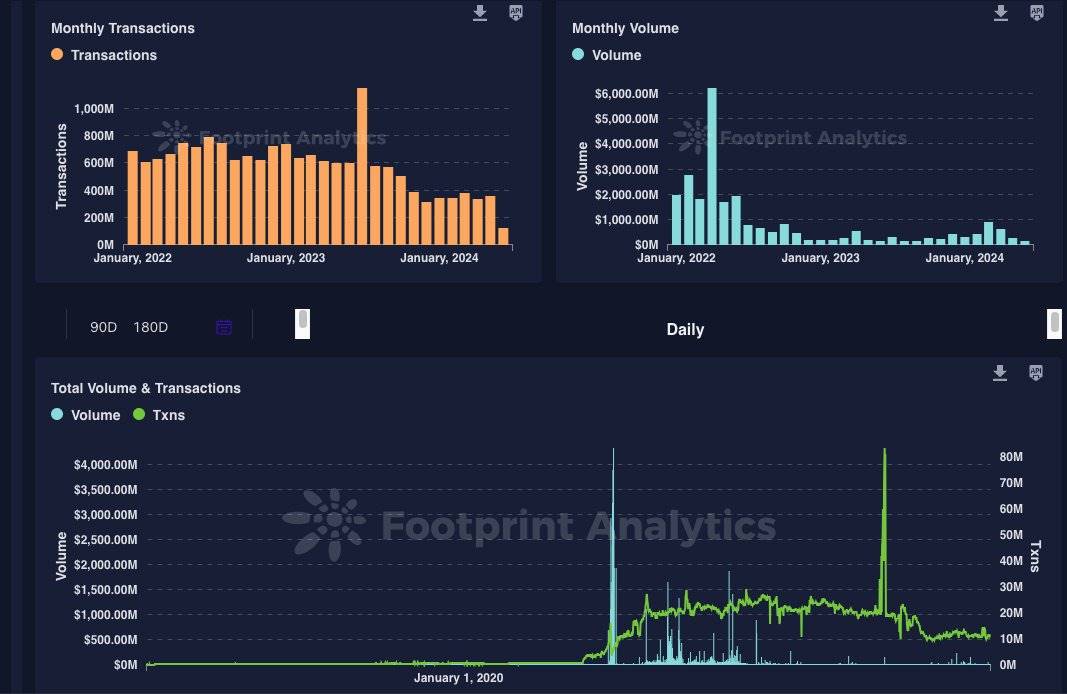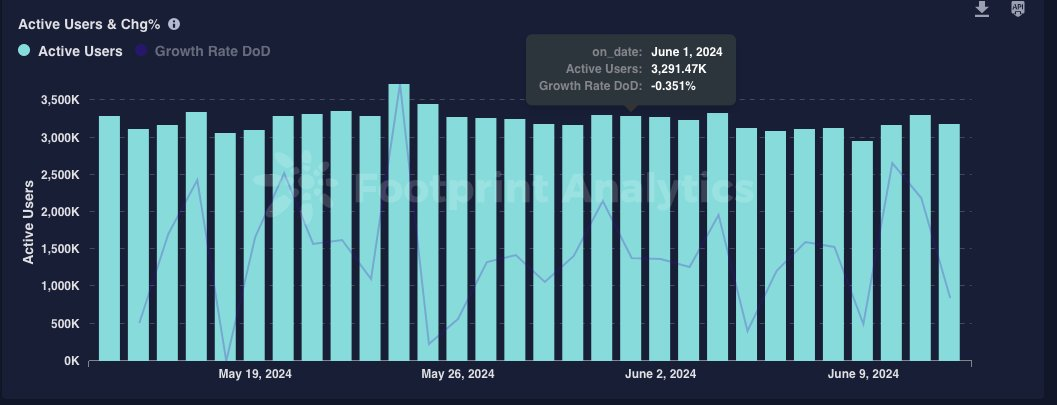原作者: Footprint Analytics
原文翻译:TechFlow
There has been some discussion lately about whether blockchain gaming is dead, and there are good points on both sides. Let鈥檚 analyze it from a data perspective.
Active games
As of May, the Footprint platform tracks 3,153 games, of which 263 games have more than 1,000 monthly active users (MAU), accounting for 8.2% of the total. If the standard is raised to 10,000 MAU, this number will be significantly reduced. It should be noted that these data only include on-chain users. Many games allow users to play without wallet login, while still including Web3 elements. Currently, this part of the data is difficult to obtain, which may affect the statistics of the actual number of players.

Daily active users and transactions
In May, daily active users (DAU) of Web3 games grew by 9.6% to 3.3 million users, but transaction volume dropped significantly from April (down $390 million). The growth in DAU is a good sign, but this growth should also be accompanied by an increase in transaction volume. Transaction volume is an important indicator of whether a game is interesting enough to incentivize players to spend money. Users playing without contributing to the game are more inclined to value extraction rather than investment. The correlation between the average users game time and transaction volume in May is worth further exploration.


Reasons for high new user growth but low transaction volume
The recent implementation of the play and get airdrops 机制 in games may be the main reason for this phenomenon. Although it works well in the short term, it may have a negative impact on the project in the long run. The practice of using incentives to attract user retention can help improve indicators, but without a solid game foundation, there may be a token sell-off after the airdrop, just like the single token economic model, which may lead to an unrecoverable death spiral.
Retention rate
Retention is one of the best metrics for measuring how fun a game is . In traditional Web2 games, the benchmarks for retention are: Day 1, 30-40%; Day 7, 20%; Day 30, 5-10% . In Web3, these retention benchmarks are harder to hit, but there are some games that do very well with Day 7 retention. Here are some examples of games with over 50,000 daily active users:
-
@ApeironNFT : 86,987 DAU; 79.3% Day 7 Retention
-
@StarryNift : 73,146 DAU; 70.8% Day 7 Retention
-
@pixels_online : 900,569 DAU; 65.6% Day 7 retention
-
@AxieInfinity : 63,385 DAU; 42.1% Day 7 retention
-
@NineChronicles : 83,360 DAU; 40% retention rate on day 7 (Note: Nine Chronicles has its own chain and is not indexed by Footprint)
Based on the retention data of the above games, it would be incorrect to think that Web3 games are dead. If other metrics are not taken into account, it can even be inferred that Web3 games perform better than traditional benchmarks in terms of retention.
Current issues limiting adoption
-
Speculation : The hype of potential profits obscures the true joy of the game.
-
User Experience/Interface : Currently, Web3 games have a lengthy registration process, and the interface is complex, difficult to use, and not aesthetically pleasing.
-
Time : Due to limited resources, games are often forced to be released before they are fully polished. Compared with traditional standards, the development time of Web3 games is longer, and many excellent Web3 games have not yet been released.
结论
At this stage, it is both right and wrong to say that Web3 gaming is dead. Games are inherently short-lived, and this is particularly evident in Web3 , as can be seen from the comparison of active and inactive games. Daily active users on Web3 recently reached an all-time high, but are these users the users the industry expects? Retention rates are high, but limited to a few games, and many games lack enough daily active users to truly measure this metric. Finally, many of the problems that existed in the early days of Web3 gaming are still visible, but these problems will be solved over time. In addition, mini-games like those on Telegram provide good examples of quickly and effectively onboarding new users into games. Blockchain does not need to revolutionize gaming, it just needs to improve it.
Web3 games are not dead, Web3 game construction is underway…
This article is sourced from the internet: Web3 game data interpretation: Active projects still have a 7-day user retention rate of over 40%
Related: Arthur Hayes: Bitcoin will fluctuate between $60,000 and $70,000 until August
Original author: Arthur Hayes Original translation: GaryMa Wu talks about blockchain Note: This article is an excerpt from the original article, and some details or information may be deleted. We recommend that readers refer to the original article while reading this article to obtain more comprehensive information. Since mid-April, some degens have been screaming “May Crisis” as they see the continued decline in the crypto market. The price action is in line with my expectations. US tax season, concerns about future Fed policy, the Bitcoin halving event, and slowing growth in US Bitcoin ETF asset management (AUM) have combined to produce a much needed market cleanup in the first two weeks. Speculators or short-term investors, they may choose to temporarily exit the market and wait and see what happens next.…







